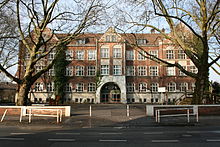Gicker
Bickern was originally a purely agricultural municipality in Westphalia , which on August 13, 1897 was renamed Wanne after the higher-level office and became part of the newly founded town of Wanne-Eickel on April 1, 1926 under this name . Since the incorporation of Wanne-Eickel into Herne on January 1, 1975, the area of the former municipality of Bickern has also been part of the urban area of the independent city of Herne.
Bickern was neither an official district of Herne when it belonged to the city of Wanne-Eickel nor is it currently an official district , but is merely the name for a residential area within the district of Herne-Wanne .
Soon after the renaming from Bickern to Wanne, the original name was only used for the central area of the old village center. This is the part of the district that lies west of today's Schlachthofstrasse .
geography
Today's residential area Bickern borders ( starting clockwise in the north) with the following districts of Herne: Our Fritz / Crange , Wanne and Röhlinghausen and in the west with the independent city of Gelsenkirchen .
history
Although Bickern was first mentioned in writing in 1220 as Byckeren in a bailiff of the Essen monastery , it can be assumed that the village has existed since the Carolingian era , as the mention of the sub- peasantry villa Wanomhana proves for the 9th century is. The villa Wanomhana fell desolate over time , but its name was retained in the form of the later collective name Wanne .
On March 6, 1690 Conrad von Strünkede by Elector Friedrich III. of Brandenburg with the high and low jurisdiction over the village Bickern invested .
In 1808 Bickern belonged to the Mairie Herne and then it was part of the mayor's office of Herne .
In the year 1824 the district of Bickern was divided into the three field corridors Wanne , Riemker Mark and Bickern in the cadastral survey .
In 1844 Bickern belonged to the Herne office . On August 1, 1875, this office was divided and the communities of Bickern, Crange, Eickel , Holsterhausen and Röhlinghausen were assigned to the newly established Wanne office, which belonged to the Bochum district . The name of the new office was an old field name in a depression that goes back to the former underpeasantry villa Wanomhana of the early Middle Ages . The naming of the new office was a compromise solution to settle a dispute between the communities of Bickern and Eickel on the occasion of the name of the common station on the Duisburg-Dortmund railway line built in 1847 by the Cologne-Mindener Railway , the site of which was exactly on the boundary between the two communities. On August 13, 1897, the name of the superior Wanne office was transferred to the municipality of Bickern.
The name Bickern remained alive in the population even after the renaming to Wanne for the central core of the former village and still refers to a residential area in the Herne-Wanne district, which extends west from today's Schlachthofstraße to the city limits of Gelsenkirchen.
politics
The SPD has its own local association in Bickern.
Culture and sights
Sports
Football plays an important role in Bickern. This sport is represented locally by two clubs, on the one hand by the SFT Bickern Wanne 1919 e. V. and on the other hand from the DJK Bickern Wanne e. V.
Attractions
The old Jewish cemetery, built around 1843, is located on today's Dürerstrasse .
Sons and daughters of the church
- Herbert FW Tengelmann (1896–1959), lawyer, businessman and industrialist
literature
- Erwin Roloff: Wanne-Eickel. Eine Stadt im Revier , 3rd edition, Wanne-Eickel 1971.
- Wolfgang Berke : The book on the city of Wanne-Eickel. Myths, cults, records: a journey through time through the heart of the Ruhr area , Essen 2002, ISBN 978-3-89861-122-0 . ( Digitized version )
- Wolfgang Berke: Wanne-Eickel - the second book on the city. Even more myths, cults and records: The journey through time continues , Essen 2005, ISBN 978-3-89861-447-4 . ( Digitized version )
Web links
Individual evidence
- ↑ a b Stephanie Reekers: The regional development of the districts and communities of Westphalia 1817-1967 . Aschendorff, Münster Westfalen 1977, ISBN 3-402-05875-8 , p. 291 .
- ^ Federal Statistical Office (ed.): Historical municipality directory for the Federal Republic of Germany. Name, border and key number changes in municipalities, counties and administrative districts from May 27, 1970 to December 31, 1982 . W. Kohlhammer, Stuttgart / Mainz 1983, ISBN 3-17-003263-1 , p. 329 .
- ^ Erwin Roloff: Wanne-Eickel. Eine Stadt im Revier , 3rd edition, Wanne-Eickel 1971, p. 9.
- ↑ information board Bickerer yards
- ^ SPD local association Bickern
- ↑ SFT Bickern Wanne 1919 on community.fussball.de
- ↑ BJK Bickern Wanne on www.fussball-im-verein.de
- ^ Elfi Pracht-Jörns : Jewish Cultural Heritage in North Rhine-Westphalia, Part V: Arnsberg District (= contributions to the architectural and art monuments of Westphalia, Volume 1.3), JP Bachem Verlag , Cologne 2005, ISBN 3-7616-1449-7 , Pp. 188–193, here p. 192.
Coordinates: 51 ° 31 ' N , 7 ° 9' E






